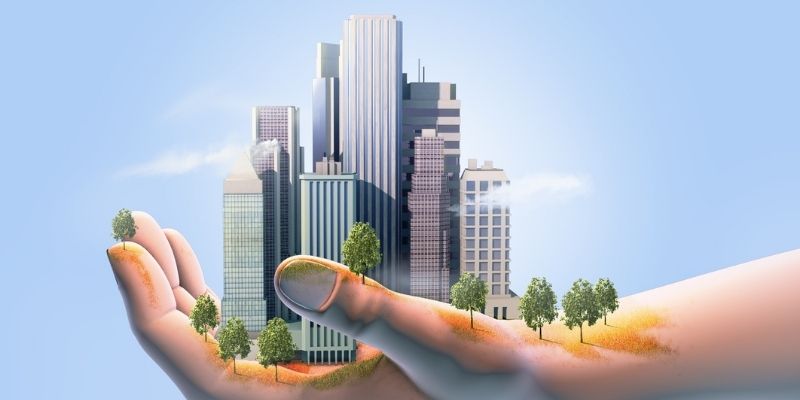Some sectors cause a great deal of pollution, and the construction sector is one of the prominent ones that causes this situation. Due to the work done and the materials used, the construction industry is an industry that uses and consumes global resources. To transfer global resources to future generations, every sector must adopt an environmentalist attitude. For this reason, sustainable construction is gaining meaning and importance day by day. This attitude tries to minimize the construction sector’s social, environmental, and economic impacts when planning, constructing, and operating structures. While doing this, it pays attention to the most commonly used materials. For example, environmentally friendly products such as Greenweight crane counterweights that can reduce CO2 emissions up to 5-6 times are used. When considering this building’s long-term benefits, this approach is a good investment in our future.
What is Sustainable Construction?
Sustainable construction means decreasing energy use, increasing and protecting green areas, and using renewable and recyclable materials while building any structure. The main thing in this environmental approach is to reduce waste and energy consumption whenever possible. It is a kind of conscious effort to protect the ecosystem around the construction and minimize waste and energy use. In short, an environmentally friendly approach is adopted throughout the entire life cycle of the building. With this approach, the environmental impacts of the construction sector are reduced in particular. Renewable materials, sustainable energy use, reducing waste, and designing the building to reduce energy consumption even after construction is finished are among the basic principles of this approach.
The Goals
For a more sustainable future, the construction industry has goals to achieve. Each target supports and enhances this environmental approach. Every goal achieved through this construction causes significant environmental impacts in the long run. For example, it is tried to increase energy efficiency and thus reduce energy consumption. Energy efficiency is increased with good insulation, the use of resources such as solar and wind energy, and good natural lighting. The increase in indoor comfort also significantly reduces energy consumption. Attention is paid to good airflow, natural lighting, and the use of healthy building materials. A conscious effort is also made to protect water resources. Rainwater harvesting, water purification, and water-saving fixtures are used to conserve water resources and reduce water use. In addition, the choice of materials used during construction is also very important. Renewable, recyclable, and less harmful materials should be preferred. It is also necessary to protect green areas, the ecosystem, and biodiversity around the construction.
Materials Used in Sustainable Construction
It is very important to know which materials will be used in construction. Environmentally friendly products, such as renewable and recyclable materials become prominent in this part. For example, It does not require electricity for wood processing, so it is a material that fits the logic of sustainable construction. Wood can be obtained by managing forests properly. In this way, it can be ensured that both renewable materials and biodiversity are protected. It is a sustainable construction material that stands out with its easy accessibility compared to materials such as plastic. Plastic and other garbage can also be converted into concrete substitutes, thus preventing CO2 emissions caused by concrete production. Bricks are thrown into the kiln fire to be stronger and therefore cause pollution through greenhouse gases. To avoid this, equally strong bricks are obtained with untreated clay or wool. This material is also ideal for this construction. Concrete or plaster is preferred for insulation in traditional buildings, but straw bales are also a very effective alternative.
Importance of Sustainable Construction
The construction industry has many different negative effects on the environment. The degradation of ecosystems, the loss or reduction of green habitats, and the large-scale energy used at the construction site are very harmful. With the help of an environmentally friendly approach like sustainable construction, the use of fossil fuels is also avoided. All the decisions have environmental effects. Making these decisions with a sustainable understanding creates a positive impact not only environmentally but also socially and economically. Because the construction industry is responsible for the majority of the world’s energy use and CO2 emissions, every sustainable decision has importance. In addition to these, raw material mining also causes pollution of waterways. An environmentalist attitude significantly reduces all these negative effects and makes a valuable investment in the future. From this point of view, it becomes an important approach.
Benefits of Sustainable Construction
This construction approach provides a multi-faced benefit. This benefit is reflected in lives environmentally, socially, and economically. Significant environmental benefits include reducing waste and carbon footprints and protecting water resources and natural habitats. Adapting a sustainable attitude reduces greenhouse gas emissions in a direct way. Social benefits include a healthier life, a good reputation, and a global impact. The sustainable approach enhances the inner quality of life and promotes a healthier life. In addition, this approach leaves a positive impact on everyone and builds a better reputation. It also has many economic benefits. Recyclable and renewable materials reduce costs. In addition, green buildings increase in value day by day and offer a great financial return in the long run.
The Challenges
Although the effects of this construction are positive, it is not that easy or comfortable to implement. This approach can’t be adopted and put into practice very quickly. Sharing this attitude with customers and budget planning will be factors that facilitate or complicate this process. The architect who will design the project should be familiar with the actions appropriate to this attitude. These actions include zero operational carbon, zero embodied carbon, sustainable water use, sustainable land use, and biodiversity. When starting a project, everything aimed at the beginning is tried to be done with the minimum cost, but this construction can have high costs. Construction companies that are afraid of this situation may also avoid adopting this attitude.



